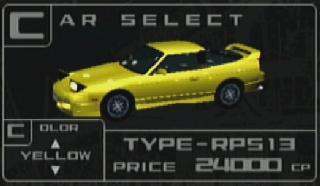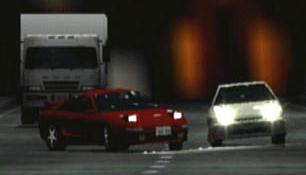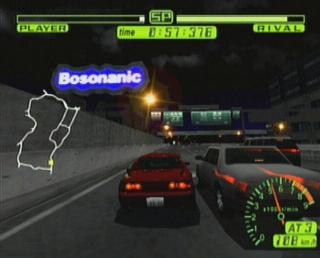No wonder Godzilla destroyed the city . . .
Taking the turn at over 100 mph, I drop gears, hoping to explode out of the curve
with a surge of acceleration. Unbeknownst to me, there’s a cement divider in the
middle of the road that spells my certain death. I try to steer out of the way,
but the car turns like it’s stuck in mud on top of a layer of ice. I hit the divider
at full speed, seeing my life flash before my eyes. Then, I bounce…
Ever since Pole Position, I’ve been a fan of racing games. Ranging from
arcade wackiness to realistic simulations, racing games are an integral part
of any video game collection. Some games, like Gran
Turismo, redefine the genre and bring it to new heights. Others, like Tokyo
Xtreme Racer, show you just how bad the genre can be.
Being one of the first racing games on the Dreamcast, you have to take its graphics with a grain of salt. Sure, the cars are crisp and the light sourcing is well done, but how much of that is the machine and how much is the game? From a graphics standpoint, Tokyo Xtreme Racer looks like a decent tech demo for the Sega Dreamcast.
Unfortunately, it also plays like one. Gameplay is just plain boring. There
is only one track. That’s right – only one. You can pick the direction
you drive on the highway, but that’s it. No tracks to open. No secret levels.
Just one, big, circular highway.
The normal mode of play is called Quest mode. In it, you drive along the highway
until you see one of your “rivals” (conveniently labeled with a red arrow).
To start a race, you have to flash your high beams at the car and away you go.
You don’t have a particular start or finish line. Instead, each of you have
health meters. The person in second place constantly loses life at a rate based
on their distance from the other car. The further behind you get, the quicker
your life goes down, and vice-versa. While this is a new take on the old racing
formula, it’s the only shining point of the game.
Tokyo Xtreme Racer has one of the worst physics models in a video game,
ever. Taking a cue from Gran Turismo, there is no damage modeling in
the game. While annoying, that doesn’t necessarily drive the game to the garbage
heap. The problem arrives when you hit a wall . . . and bounce. You can be going
150 mph, and hitting a wall dead-on will cause you to bounce back about 10 feet
and stop. No flipping, no spinning, just one big bounce. Physics like this have
never existed outside of Wackyland.

However, if the consequences were worse, the game would be unplayable. That
sad fact is due to the horrible control. Ever driven on a surface made entirely
of peanut butter? It’s sticky one minute, then slippery the next. Novice players
will constantly hit the wall on every turn (not that that’s a big problem) and
eventually throw the controller away in disgust.
While the physics model is even more unrealistic than the one found in SF
Rush, the designers got it in their heads that they were designing some
sort of sim, so they added a ton of upgrades to your car. There are over 100
different accessories to add to your car, but they all suffer from the same
Wackyland physics model. To quote from the manual: “Raising the car height increases
the force with which your tires press against the ground.” Wow, I wonder if
Newton knew that!
There is a Versus mode in the game which uses the tried-and-true split screen
setup. Giving kudos where they’re due, I’d like to congratulate the makers of
the Dreamcast for having a machine that can handle a split-screen without too
much framerate loss. Other than that, it’s still the same game, only now you’re
inflicting it on one of your friends.
In the end, Tokyo Xtreme Racer is the worst Dreamcast title to date.
With Flag to Flag already out and more racing games coming in the near
future, Tokyo Xtreme Racer should be left on the shelves. End of story.

-
New "Battle-racing" System
-
Wacky Physics
-
No Damage Modeling
-
Horrible Controls











